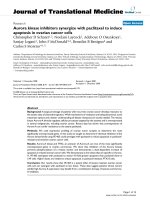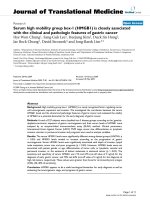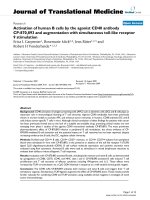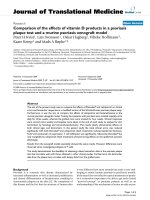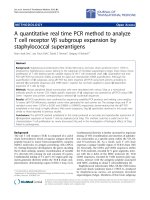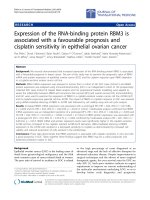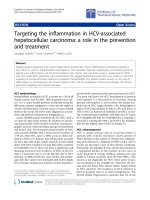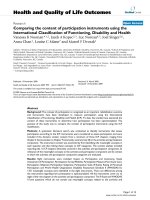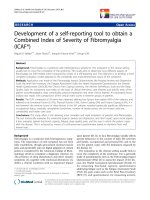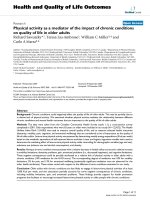báo cáo hóa học: "Overground walking speed changes when subjected to body weight support conditions for nonimpaired and post stroke individuals" docx
Bạn đang xem bản rút gọn của tài liệu. Xem và tải ngay bản đầy đủ của tài liệu tại đây (1.05 MB, 11 trang )
JNER
JOURNAL OF NEUROENGINEERING
AND REHABILITATION
Burgess et al. Journal of NeuroEngineering and Rehabilitation 2010, 7:6
/>Open Access
RESEARCH
© 2010 Burgess et al; licensee BioMed Central Ltd. This is an Open Access article distributed under the terms of the Creative Commons
Attribution License ( which permits unrestricted use, distribution, and reproduction in
any medium, provided the original work is properly cited.
Research
Overground walking speed changes when
subjected to body weight support conditions for
nonimpaired and post stroke individuals
Jamie K Burgess*
1
, Gwendolyn C Weibel
2
and David A Brown
1
Abstract
Background: Previous research has shown that body weight support (BWS) has the potential to improve gait speed
for individuals post-stroke. However, body weight support also reduces the optimal walking speed at which energy use
is minimized over the gait cycle indicating that BWS should reduce walking speed capability.
Methods: Nonimpaired subjects and subjects post-stroke walked at a self-selected speed over a 15 m walkway. Body
weight support (BWS) was provided to subjects at 0%, 10%, 20%, 30%, and 40% of the subject's weight while they
walked overground using a robotic body weight support system. Gait speed, cadence, and average step length were
calculated for each subject using recorded data on their time to walk 10 m and the number of steps taken.
Results: When subjected to greater levels of BWS, self-selected walking speed decreased for the nonimpaired subjects.
However, subjects post-stroke showed an average increase of 17% in self-selected walking speed when subjected to
some level of BWS compared to the 0% BWS condition. Most subjects showed this increase at the 10% BWS level. Gait
speed increases corresponded to an increase in step length, but not cadence.
Conclusions: The BWS training environment results in decreased self-selected walking speed in nonimpaired
individuals, however self-selected overground walking speed is facilitated when provided with a small percentage of
body weight support for people post-stroke.
Background
Locomotor disability remains a major obstacle to com-
munity function in persons with chronic post-stroke
hemiplegia. This disability is best characterized by a
reduced gait speed that is observed in the majority of per-
sons with post-stroke hemiplegia and has been shown to
be correlated with other parameters such as balance, use
of walking aids, number of falls, and ability to perform
activities of daily living [1]. Rehabilitation programs often
tackle the challenge of gait training post stroke with one
or more interventions that include overground gait train-
ing, body weight support treadmill training (BWSTT),
and/or strength training [2]. For example, body weight
support has been utilized over a treadmill with the goal to
unload a percentage of body mass and provide external
support so that weight shifting, balance and stepping can
be guided by the clinician at regulated speeds [3]. A pri-
mary motivation of this particular therapeutic method is
to improve gait speed for people post stroke [4]. However,
there is limited literature that explores how overground
walking speed is altered while subjected to the body
weight support environment for people post stroke dur-
ing walking.
For people with an intact nervous system, supporting a
percentage of body weight during walking would theoret-
ically slow gait speed due to the minimization of energy
expenditure across the gait cycle optimally occurring at a
lower speed [5-7]. The determination of this optimal
comfortable walking speed depends on several factors
such as leg length, limb stiffness, and body load [8]. Sub-
sequently, energy expenditure occurs optimally at a
reduced speed as a result of reduced body load [8].
Despite the biomechanical evidence that a reduced
speed for a nonimpaired person might occur while sub-
jected to body weight support during walking, there are
* Correspondence:
1
Department Of Physical Therapy and Human Movement Sciences,
Northwestern University, Chicago, IL, USA
Burgess et al. Journal of NeuroEngineering and Rehabilitation 2010, 7:6
/>Page 2 of 11
possible reasons why walking speed for someone with
post-stroke hemiplegic gait might be facilitated during
the BWS condition. For instance, since an individual with
hemiplegia due to stroke injury walks with a slow speed,
the reduction in net body weight could allow for a greater
ability to propel the body forward when there is a weak-
ness in one of the legs since there is a direct relationship
between preferred walking speed and paretic leg propul-
sive impulse [9,10]. Additionally, increases in walking
speed often correspond to a larger proportion of the gait
cycle spent in single stance [11]. Body weight support
would relieve loading on legs during the single support
phase allowing an individual with stroke to remain in that
phase longer and lessen the amount of time in double
stance [11]. Finally, one of the primary motivations of
body weight support treadmill training is the assumption
that it facilitates the rhythmic spinal neuron pools for
people post stroke [12]. Since the motor output of these
central pattern generators is shaped by afferent feedback
[13], BWSTT is hypothesized to promote improved walk-
ing function through the repetitive input of task-specific
sensory feedback [14].
In summary, biomechanical evidence suggests that
reduced speed might occur when subjected to body
weight support during walking for a nonimpaired person,
but an increased walking speed might occur for someone
with post-stroke hemiplegic gait. We tested these predic-
tions by exploring changes in self selected walking speed
when subjected to body weight support for these two
populations. We hypothesized that self selected walking
speed for nonimpaired subjects would show a decreasing
trend with increasing levels body weight support. In con-
trast, subjects post stroke would show an increase in self
selected walking speed at some level of body weight sup-
port when compared with walking overground with no
body weight support.
Methods
Subjects
Eleven neurologically nonimpaired subjects aged 40-72
(mean = 50, SD = 9) and twelve subjects aged 27-68
(mean = 52, SD = 12) presenting with chronic stroke con-
sented to participate in this study. Relevant criteria for
recruitment of nonimpaired subjects were as follows:
over 40 years in age, no history of cardiac disease that
would prevent them from participating in mild exercise,
and able to walk 10 m unassisted. Relevant clinical mea-
sures are presented in Table 1 for the subjects post stroke.
For this group, inclusion criteria consisted of unilateral
stroke greater than 12 months past onset resulting in
hemiplegia, medically approved for physical therapy, and
were partially ambulatory such that a 15 m walk could be
completed without the use of an assistive device other
than an ankle-foot orthosis. The exclusion criteria were
limited to the following: severe cardiac disease, a history
of premorbid gait disorder of any cause, and an inability
to follow simple commands. To characterize the group of
subjects post stroke, subjects completed the Berg Balance
Test and Lower Limb Fugl Meyer exam less than a week
prior to completing the experimental protocol. This study
Table 1: Clinical Features of Subjects Post Stroke
Subject Age (Years) Side of
Paresis
Months Post
Stroke
Berg Balance
Score
Fugl Meyer
Score
6 min walk
speed (m/s)
165L24744130.58
258L13455271.25
346L1684080.5
4 68 R 26 50 23 0.98
5 59 R 51 44 14 0.81
6 37 L 27 41 12 0.34
7 27 L 42 56 26 1.06
845L274590.53
954L24045150.62
10 60 R 64 53 13 0.35
11 53 R 74 45 14 0.35
12 55 R 264 56 19 1.06
Mean: 52 - 114 48 16 0.7
SD: 12 - 93 6 6 0.32
Burgess et al. Journal of NeuroEngineering and Rehabilitation 2010, 7:6
/>Page 3 of 11
was performed at the Rehabilitation Institute of Chicago
and informed consent was obtained according to the pol-
icies of Northwestern University Institutional Review
Board. Nonimpaired subjects were associated with the
Rehabilitation Institute of Chicago and subjects post
stroke were recruited through the Rehabilitation Institute
of Chicago's Stroke Research Registry. Recruitment and
clinical testing was completed by a research physical ther-
apist.
KineAssist Gait and Balance Training System
The KineAssist Gait and Balance Training System™ con-
sists of a custom designed torso and pelvis harness
attached to a mobile robotic base (Fig 1). The KineAssist
utilizes a servomechanism to drive the robot according to
the forces detected from the subject by the load cells
located in the pelvic harness. This device has been
described extensively elsewhere [15]. Patton et al., char-
acterized the effect of this device on walking speed and
found that it slows walking speed while still allowing the
user to maintain normal walking kinematics [16]. This
manner of admittance control slightly slows the user in
order to promote safety and stability [16]. To accomplish
overground walking with body weight support, the Kine-
Assist offers closed loop body weight support continu-
ously throughout the gait cycle, while the individual
walks over ground. The vertical column provides this
body weight support continuously while still allowing
vertical movements of the pelvis.
Protocol of Experiment
A 15 m track was set up for this experiment using tape to
demark the straight-line path subjects were to follow.
Only the performance during the middle 10 m were used
in data collection; the first and last 2.5 m were used as
buffer zones to avoid reporting the gait changes associ-
ated with starting and stopping gait. The 10 m distance
was selected as the evaluation distance due to its com-
mon use in assessing comfortable walking speed in a clin-
ical setting. It is also short enough to avoid the negative
effects of fatigue for the subjects post stroke. Subjects
were encouraged to walk as they normally would at a
comfortable pace for every trial. For both subject groups,
the first experimental trial consisted of walking 15 m
unaided by the KineAssist while time to walk 10 m was
recorded with a stopwatch and number of steps was man-
ually counted within the 10 m length. For the purposes of
this study, steps taken while the foot was planted on the
start and/or finish line were included. A pseudo-random
level of body weight support was presented to the subject
via the KineAssist ranging from 0% BWS to 40% BWS, at
10% intervals, during subsequent trials for the nonim-
paired subjects. BWS levels were randomized using Mat-
lab™ for each subject. Subjects post stroke were presented
with sequentially increasing levels of BWS over the same
range and intervals of BWS. This was done because sub-
jects post stroke showed discomfort when presented with
intervals of BWS larger than 10% presented between tri-
als. Additionally, one subject post stroke was unable to
complete the task at the 40% BWS level due to an inability
to maintain a normal walking pattern for this subject.
The final trial for both subject groups was a repetition of
the first trial wherein subjects walked 15 m without the
use of the KineAssist.
Data Analysis
The speed for each trial was computed using the distance
of 10 m divided by the recorded time to complete that
distance. Average step length was calculated by dividing
the 10 m distance by the number of steps recorded.
Cadence was calculated by dividing the number of steps
taken during the 10 m by the time needed to complete the
10 m.
We normalized all of the speed, cadence, and average
step length data that were collected during the trials com-
pleted with the use of the KineAssist. This normalization
had the primary effect of allowing evaluation of intrasu-
bject changes in self selected walking speed with BWS
and removed the large variability seen in self selected
Figure 1 The KineAssist in use.
Burgess et al. Journal of NeuroEngineering and Rehabilitation 2010, 7:6
/>Page 4 of 11
walking speeds. Each variable measured at the 10%-40%
BWS level was divided by the same variable measured at
the 0% BWS level and was expressed as a percentage
change from the 0% BWS level. From this normalization
protocol, we directly determined if a subject had
increased or decreased his or her self selected walking
speed with BWS from the 0% BWS level. For example, if
the normalized percentage change in speed was positive,
then an increase in self selected walking speed at the cor-
responding level of BWS would have occurred.
Statistical analyses were completed on the normalized
data. One sample t-tests were completed to test the
hypothesis that there were significant changes from the
0% BWS condition for each level of body weight support
for velocity, cadence and average step lengths for each
group. Significance was evaluated at P < 0.05. Data values
are presented as the mean ± standard deviation. Plots are
shown with confidence intervals.
We determined the maximum percent increase in
velocity and maximum percent decrease in velocity for
both subject groups by detecting the maximum values at
any of the body weight support conditions (10%-40%
BWS). We averaged the step length and cadence values
associated with the maximum velocity values in order to
determine which of these two factors might explain the
increased walking velocity values. Additionally, we gener-
ated a histogram to examine the frequency with which
the maximum velocity for each subject occurred at each
body weight support level for each subject group.
Results
Nonimpaired subjects
When nonimpaired subjects walked 10 m without the use
of the KineAsssist, their mean self selected walking speed
was 0.5 m/s greater than walking in the KineAssist with-
out any BWS (1.2 ± 0.2 m/s mean walking speed over-
ground, 0.7 ± 0.2 m/s mean walking speed overground
using KineAssist with no BWS). The nonimpaired sub-
jects' self selected overground walking speed when walk-
ing with the KineAssist showed a downward trend as
BWS increased (Fig 2, A). Additionally, average step
length showed a decreasing trend as level of BWS
increased. Cadence remained steady across all trials (Fig
2, B and 2C).
Figure 2 Velocity (A), average step length (B), and cadence (C) for non-impaired subjects walking at different levels of BWS. The dark solid
line is the mean and 95% confidence intervals for all nonimpaired subjects. The lighter solid lines represent individual subject data.
0 10 20 30 40
0
0.2
0.4
0.6
0.8
1
1.2
Percentage of Body Weight Supported
Velocity (m/s)
A
0 10 20 30 40
0
0.1
0.2
0.3
0.4
0.5
0.6
0.7
Percentage of Body Weight Supported
Average Step Length (m)
B
0 10 20 30 40
0
0.2
0.4
0.6
0.8
1
1.2
1.4
1.6
1.8
2
Percentage of Body Weight Supported
Cadence (steps/sec)
C
Burgess et al. Journal of NeuroEngineering and Rehabilitation 2010, 7:6
/>Page 5 of 11
Each self selected walking speed, cadence, and step
length measure recorded in the KineAssist was normal-
ized to the respective measure obtained at the 0% BWS
level in the KineAssist. The normalized data showed a
decline in changes in self selected walking speed in the
KineAssist from the 0% BWS level as BWS levels were
increased (Fig 3, A). A linear regression with a least
squares fit of individual subject data resulted in an aver-
age slope of -0.0038 ± 0.008%velocity change/%BWS (p <
0.05). Additional analysis of the y-intercept revealed that
the estimated y-intercept was not significantly different
from 0% (y = 0.04, p > 0.05). This value was expected
since every value was normalized to 0% velocity change at
0% BWS. Additionally, the average step length with BWS
also decreased with a slope of -0.03 ± 0.0003 m/%BWS (p
< 0.05) and cadence varied little across different levels of
BWS (Fig 3, B and 3C).
A histogram of how many subjects attained their maxi-
mum speed increase in the KineAssist at each level of
BWS showed that there was a skew towards the 10% BWS
level despite a lack of a significant increase in self selected
walking speed in the KineAssist at that level (Mean veloc-
ity percentage change at 10% BWS = 1.02 ± 0.13%, p >
0.05 Fig 4).
Subjects post-stroke
The average self selected walking speed without the use
of the KineAssist for subjects post stroke was 0.8 ± 0.3 m/
s. When using the KineAssist with no BWS, the average
self-selected walking speed was 0.4 ± 0.1 m/s. Average
step length also shortened from 0.5 ± 0.08 m without the
use of the KineAssist to 0.3 ± 0.08 m when using the Kin-
eAssist with 0% BWS.
The self selected walking speed data collected in the
KineAssist from subjects post-stroke showed high vari-
ability among subjects as expected (Fig 5, A). This high
variability was also apparent with the average step length,
and cadence data (Fig 5, A, B, and 5C, respectively).
Upon normalization, the mean across subjects of the
self selected walking speed in the KineAssist showed a
13% increase at the 10% BWS level over the self selected
walking speed in the KineAssist at the 0% BWS level (Fig.
6, A; 1.13 ± 0.18%, p < 0.05). Higher levels of BWS did not
elicit any significant speed increases from the 0% BWS
Figure 3 Normalized velocity (A), average step length (B), and cadence (C) for non-impaired subjects walking at different levels of BWS. The
dark solid line is the mean and 95% confidence intervals for all nonimpaired subjects. The lighter solid lines represent individual subject data.
0 10 20 30 40
−40
−20
0
20
40
60
Percentage Body Weight Supported
Percent Velocity Change from 0% BWS
A
0 10 20 30 40
−40
−20
0
20
40
60
Percentage of Body Weight Supported
Average Step Length (m)
B
0 10 20 30 40
−40
−20
0
20
40
60
Percentage of Body Weight Supported
Cadence (steps/sec)
C
Burgess et al. Journal of NeuroEngineering and Rehabilitation 2010, 7:6
/>Page 6 of 11
level speeds for subjects post-stroke. Normalized average
step length in the KineAssist showed an 11% increase
from the 0% BWS level at the 10% BWS level (Fig 6, B and
6C).
Examination of the slopes of the individual self selected
walking speeds in the KineAssist over the 10%-40% BWS
levels revealed that the mean slope was significantly dif-
ferent than 0 (mean slope = -0.08 ± 0.008% velocity
change/% BWS, p < 0.05). Additionally, the y-intercept
was also significantly different than 0% (y-intercept =
1.211 ± 0.02, p < 0.05).
Despite the group mean of self selected walking speed
changes in the KineAssist showing a statistically signifi-
cant increase at the 10% level of BWS, individual subjects
showed maximum self selected walking speed increases
in the KineAssist at a variety of BWS levels. At least half
of the subjects had their maximum KineAssist walking
speed at a BWS level other than 10% (Fig 7) and three
subjects did not show an increase in speed at any level of
BWS over the 0% BWS level.
We grouped all BWS conditions together to calculate
the mean maximum percent increase and maximum per-
cent decrease in self selected walking speed in the Kine-
Assist over all levels of BWS. There was a significant
increase in self selected walking speed in the KineAssist
at any level of BWS (Fig 8, A, mean maximum percent
increase in speed = 17.5 ± 21.0%, p < 0.05). Also, an
examination of the maximum percent decrease in self
selected walking speed in the KineAssist showed that
subjects post-stoke experienced a significant decrease in
walking speed at any level of BWS (Fig 8A, mean maxi-
mum percent decrease = 14.9 ± 19.3%; p < 0.05 and p <
0.05 respectively).
Subjects significantly increased their average step
length in the KineAssist at the maximum speed attained
for each subject when compared to each subjects' average
step length at the 0% BWS level (Fig 8B, 14.3 ± 18.1% p <
0.05). The changes in cadence were not significantly dif-
ferent than zero percent change for any level of BWS (Fig
8B, p > 0.05).
Discussion
The systematic decline in self selected walking speed in
the KineAssist with increasing levels of BWS as seen in
neurologically nonimpaired subjects was expected due to
model predictions from a previous study that modelled
the interaction between gravity and self-selected walking
speed [17]. During the gait cycle, there is a continuous
transformation of potential and kinetic energy. The effi-
ciency of this transformation depends on the mass of the
individual, the effect of gravity acting on that mass, and
the speed that the mass is travelling [17]. When there is a
reduction in the effective weight of an individual, the
speed that the individual is walking ideally must be
reduced in order to minimize the level of energy expendi-
ture [18]. Since we obtained a reasonably linear relation-
ship (R
2
= .96) between self-selected comfortable walking
speed and level of BWS, the expected decrease is sup-
ported.
The self-selected walking speeds in the KineAssist of
subjects with post-stroke hemiparesis showed variation
from the prediction of the nonimpaired model in that
their average percent velocity change in response to
increasing levels of BWS over 0% BWS in the KineAssist,
did not decrease but instead showed an increase at 10%
BWS. There must be an alternate mechanism or mecha-
nisms that people post-stroke utilize to determine self
selected walking speed.
The data collected in this study was spatio-temporal in
nature and, therefore, we acknowledge that we cannot
suggest specific mechanistic causes that underlie these
observations. However we propose three possible mecha-
nisms that might account for the increase in self-selected
walking speed in the KineAssist in post-stroke individuals
Figure 4 Number of nonimpaired subjects that attained the max-
imum percentage change in velocity at each level of BWS.
0% 10% 20% 30% 40%
1
2
3
4
5
6
BWS Level
Number of Subjects
Burgess et al. Journal of NeuroEngineering and Rehabilitation 2010, 7:6
/>Page 7 of 11
when provided body weight support in support of future
studies in regards to how BWS and sensory feedback
regarding loading might alter and improve locomotion
post stroke.
The first of these potential mechanisms is that BWS
can compensate for paretic leg muscle weakness leading
to improved propulsion and decreased asymmetry in
force production. Weakness is a common issue that arises
post-stroke that is characterized by a reduction in force
production from muscle [10]. When body load is sup-
ported, weak muscles can better match the physical
demands of locomotion potentially leading to a more
energy efficient gait pattern [19]. Weight acceptance is
also improved similarly for both legs with BWS [19].
Additionally, improved weight acceptance associated
with BWSTT might reduce extensor spasticity associated
with loading [20].
Secondly, load related sensory feedback is critical for
generating effective gait mechanics in a nonimpaired
nervous system [21], by promoting ongoing extensor
activity during stance and facilitating phase transitions
from stance to swing [13]. Stroke has the potential to
degrade the ability of the spinal cord to appropriately
utilize load related sensory signals leading to abnormal
extensor activity during stance [22]. BWS may promote
improved output through proper sensory facilitation of
the locomotor neuron pools [3,23]. Less inappropriate
drive from these sensory afferents onto spinal neural
networks could improve the generation of appropriate
control signals driving the muscles of the lower limbs
during locomotion [24]. This improved processing
could have a beneficial effect on accurate estimation of
the location of the center of mass relative to the base of
support across the gait cycle, thus facilitating gait
mechanics.
Thirdly, reorganization of descending drive could play a
role in affecting gait speed during weight-supported loco-
motion. Previous studies suggest that corticospinal
descending pathways from the injured brain area become
less effective at generating successful motor commands
after stroke and that the nervous system relies more on
indirect, brainstem mediated descending tracts that are
often ill-suited for finer motor tasks [21,25,26]. In addi-
tion, there may be an increased reliance on the reticu-
Figure 5 Velocity (A), average step length (B), and cadence (C) for post-stroke subjects walking at different levels of BWS. The dark solid line
is the mean and 95% confidence intervals for all post-stroke subjects. The lighter solid lines represent individual subject data.
0 10 20 30 40
0
0.2
0.4
0.6
0.8
1
1.2
Percentage of Body Weight Supported
Velocity (m/s)
A
0 10 20 30 40
0
0.1
0.2
0.3
0.4
0.5
0.6
0.7
Percentage of Body Weight Supported
Average Step Length (m)
B
0 10 20 30 40
0
0.2
0.4
0.6
0.8
1
1.2
1.4
1.6
1.8
2
Percentage of Body Weight Supported
Cadence (steps/sec)
C
Burgess et al. Journal of NeuroEngineering and Rehabilitation 2010, 7:6
/>Page 8 of 11
lospinal tract, which is more adept at controlling posture
and gross movements of the trunk and proximal muscles
[27]. This would result in a loss of independent joint con-
trol between the upper and lower limbs during dynamic
weight bearing tasks such as walking [26]. Finally, work in
animals has shown that there is a greater use of reticulo-
and rubrospinal pathways after lesions of corticospinal
tracts [28]. Indeed, studies that have provided weight
support to the arm during reaching tasks for people with
post stroke hemiplegia have found a reduction in inap-
propriate coupling of joint movements allowing for
greater control of reaching movements [25].
People with post-stroke hemiparesis respond differ-
ently than nonimpaired individuals when walking over-
ground with body weight support. Specifically,
nonimpaired people show a gradual decline in self-
selected walking speed in accordance with biomechanical
models [17], but people post-stroke show an increase in
self-selected walking speed at low levels of body weight
support as shown in the data presented in this article.
Further examination of biomechanical factors such as
dynamic strength, ground reaction forces, and EMG
activity could provide insight towards potential mecha-
nisms by which this behavior occurs. However, of partic-
ular importance is this first step of observing the
nonstandard behavior seen in the post-stroke subjects
during self selected overground walking.
This study was constrained by several factors. The task
of overground walking imposed a limit of how much
body weight support we could supply to a subject that
permitted them to be able to successfully walk forwards
comfortably. This is in contrast to many previous body
weight support studies that were performed over a tread-
mill where greater levels of BWS could be studied
[4,29,30]. Despite this limitation, our results suggest that
walking speeds would continue to be compromised at
higher levels of BWS. Additionally, our observation of
degradation of walking speed at higher levels of body
weight support around 40% BWS supports results found
in other studies that recommend using levels of BWS less
than 30-45% [20,31].
For the subjects post-stroke, we were concerned about
fatigue effects during the experiment so we only per-
formed one trial at each BWS level. Additionally, we per-
Figure 6 Normalized velocity (A), average step length (B), and cadence (C) for post-stroke subjects walking at different levels of BWS. The
dark solid line is the mean and 95% confidence intervals for all post-stroke subjects. The lighter solid lines represent individual subject data.
0 10 20 30 40
−40
−20
0
20
40
60
Percentage Body Weight Supported
Percent Velocity Change from 0% BWS
A
0 10 20 30 40
−20
0
20
40
60
Percentage of Body Weight Supported
Average Step Length (m)
B
0 10 20 30 40
−40
−20
0
20
40
60
Percentage of Body Weight Supported
Cadence (steps/sec)
C
Burgess et al. Journal of NeuroEngineering and Rehabilitation 2010, 7:6
/>Page 9 of 11
formed the tests at 10% BWS intervals. However, further
examination of behaviour around the 10% and 20% BWS
levels at smaller increments would be useful in further
elucidating any possible trend. Additionally, the subjects
post stroke received the BWS in increasing increments of
BWS due to discomfort they experienced when transi-
tioning between increments of BWS higher than 10%. We
were concerned that there might be a learning effect
between trials but since we did not see a constant
increase in self selected walking speed in the KineAssist
with increasing levels of BWS, we were sufficiently satis-
fied that any possible learning effect was not apparent in
our data.
We also found that about half of the nonimpaired sub-
jects had difficulty maintaining a normal gait pattern dur-
ing higher levels of BWS. Several subjects would attempt
a "loping gait" at 30% and 40% BWS levels. This gait is
characterized by long upward jumps between steps simi-
lar to the gait maintained by astronauts walking on the
moon [17]. This loping gait was detected prior to data
collection and the trial would be restarted and instruc-
tions regarding maintaining a typical gait pattern would
be emphasized. One nonimpaired subject was excluded
because he was not able to maintain a walking gait but
instead performed this jumping gait. The subjects with
post-stroke hemiparesis were never observed performing
a loping gait and were able to complete all trials without
major deviations to the gait pattern seen at the 0% BWS
level.
Finally, we did not explore kinetic variables since we
were simply looking to explore overground self selected
speed output based on the amount of BWS provided.
We felt that self selected walking speed would reflect
global locomotor fitness and if there was significant dif-
ferences in behavior. Further experiments will be exam-
ining ground reaction forces and electromyographic
variables to deeper explore how increases in speed for
people post-stroke evolve when provided body weight
support.
Conclusions
This study found that subjects with post-stroke hemipa-
resis increased their overground self-selected walking
speeds in the KineAssist by an average of 17% when
walking with some level of body weight support com-
pared with their self selected walking speed with 0%
BWS. Conversely, when neurologically nonimpaired
subjects performed the same task, their self selected
walking speeds in the KineAssist decreased at all levels
of BWS when compared to their walking speeds with 0%
BWS. With post-stroke subjects, increased self selected
walking speed in the KineAssist was associated with
increased average step length by 14%, whereas cadence
did not change significantly over any level of BWS.
Although each individual subject post-stroke showed
increased walking velocities at different BWS levels, the
10% BWS level was the only condition that showed a
significant group average increase in speed over the 0%
BWS level.
While we did not find a defining characteristic that
indicates the subjects that would best benefit from this
type of training or what level of body weight support
would be most appropriate, we did find that most of the
stroke subjects did walk faster with some level of body
weight support. Further research is necessary in order to
determine the possible load related mechanisms that
influence gait speed for subjects post stroke in order to
inform gait rehabilitation research.
Figure 7 Number of post-stroke subjects that attained the maxi-
mum percentage change in velocity at each level of BWS.
0% 10% 20% 30% 40%
1
2
3
4
5
6
BWS Level
Number of Subjects
Burgess et al. Journal of NeuroEngineering and Rehabilitation 2010, 7:6
/>Page 10 of 11
Competing interests
DB participated as a consultant with the startup company KineaDesign, LLC,
the company that designed and build the KineAssist device. He is listed as an
inventor who will potentially receive Royalty Payments.
Authors' contributions
JB carried out data collection, analysis and drafted the manuscript. GW assisted
in data collection, completed subject recruitment, and helped draft the manu-
script. DB participated in the design of the study, statistical analysis, and draft-
ing the manuscript. All authors read and approved the final manuscript.
Acknowledgements
The authors would like to thank Dr. Elliot Roth and the Rehabilitation Institute
of Chicago for their support of research involving the KineAssist. Additionally,
KineaDesign deserves many thanks for their excellent technical support and
insight. Funding was provided by the Department of Health and Human Ser-
vices STTR Grant #5 R42 HD051240 NIH.
Author Details
1
Department Of Physical Therapy and Human Movement Sciences,
Northwestern University, Chicago, IL, USA and
2
Sensory Motor Performance
Program, The Rehabilitation Institute of Chicago, Chicago, IL, USA
References
1. Potter JM, Evans AL: Gait Speed and Activities of Daily Living Function in
Geriatric Patients. Archives of Physical Medicine and Rehabilitation 1995,
76:997-999.
2. Hesse S, Werner C, Bardeleben A, Barbeau H: Body Weight-Supported
Treadmill Training After Stroke. Current Artherosclerosis Reports 2001,
3:287-294.
3. Hassid E, Rose D, Commisarow J, Guttry M, Dobkin BH: Improved Gait
Symmetry in Hemiparetic Stroke Patients Induced During Body
Weight-Supported Treadmill Stepping. Neurorehabilitation and Neural
Repair 1997, 11:21-26.
4. Visintin M, Barbeau H, Korner-Bitensky N, Mayo N: A new approach to
retrain gait in stroke patients through body weight support and
treadmill stimulation. Stroke 1998, 29:1122.
5. Cavagna GA, Saibene FP, Margaria R: External Work in Walking. Journal
of Applied Physiology 1963, 18:1-9.
6. Cavagna GA, Thys H, Zamboni A: The Sources of External Work in Level
Walking and Running. The Journal of Physiology 1976, 262:639-657.
7. Waters RL, Lunsford BR, Perry J, Byrd R: Energy-speed Relationship of
Walking: Standard Tables. Journal of Orthopaedic Research 1988,
6:215-222.
8. Cavagna G, Willems P, Heglund N: The role of gravity in human walking:
pendular energy exchange, external work and optimal speed. The
Journal of Physiology 2000, 528:657-668.
9. Bowden MG, Balasubramanian CK, Neptune RR, Kautz SA: Anterior-
Posterior Ground Reaction Forces as a Measure of Paretic Leg
Contribution in Hemiparetic Walking. Stroke 2006, 37:872-876.
10. Olney S, Richards C: Hemiparetic gait following stroke. Part I:
Characteristics. Gait & Posture 1996, 4:136-148.
Received: 13 April 2009 Accepted: 11 February 2010
Published: 11 February 2010
This article is available from: 2010 B urgess et al; licensee Bi oMed Centr al Ltd. This is an Open Access article distributed under the terms of the Creative Commons Attribution License ( which permits unrestricted use, distribution, and reproduction in any medium, provided the original work is properly cited.Journal of NeuroEn gineerin g and Reha bilitatio n 2010, 7:6
Figure 8 Plot A indicates the maximum percent increase and maximum percent decrease in velocity that post-stroke subjects attained re-
gardless of level of support. Plot B examines the percent change in average step length and cadence recorded at a subject's maximum speed for
the post-stroke subjects.
Max Max
−30
−20
−10
0
10
20
30
40
Increase Decrease
Percent Change in Velocity from 0% BWS
A
Avg. Step Cadence
−5
0
5
10
15
20
25
30
−5
Length
Percent Change from 0% BWS at Maximum Velocity
B
Burgess et al. Journal of NeuroEngineering and Rehabilitation 2010, 7:6
/>Page 11 of 11
11. Lamontagne A: Faster Is Better: Implications for Speed-Intensive Gait
Training After Stroke. Stroke 2004, 35:2543-2548.
12. Hesse S, Konrad M, Uhlenbrock D: Treadmill walking with partial body
weight support versus floor walking in hemiparetic subjects. Archives
of Physical Medicine and Rehabilitation 1999, 80:421-427.
13. Pearson KG: Proprioceptive regulation of locomotion. Neurobiology
1995:1-6.
14. Sullivan K, Knowlton B, Dobkin B: Step training with body weight
support: effect of treadmill speed and practice paradigms on
poststroke locomotor recovery. Archives of Physical Medicine and
Rehabilitation 2002, 83:683-691.
15. Peshkin M, Brown DA, Santos-Munne JJ, Makhlin A, Lewis E, Colgate JE,
Patton J, Schwandt D: KineAssist: A robotic overground gait and
balance training device. Proceedings of the 2005 IEEE ICORR 2000:1-6.
16. Patton J, Brown D, Lewis E, Crombie G, Santos-Munne JJ, Makhlin A,
Colgate JE, Peshkin M: Motility evaluation of a novel overground
function mobility tool for post stroke rehabilitation. Proceedings of the
2007 IEEE 10th International Conference on Rehabilitation Robotics
2007:1049-1054.
17. Cavagna GA, Willems PA, Heglund NC: The Role of Gravity in Human
Walking: Pendular Energy Exchange, External Work and Optimal
Speed. The Journal of Physiology 2000, 528:657-668.
18. Cavagna GA, Thys H, Zamboni A: The sources of external work in level
walking and running. Journal of Physiology 1976:1-19.
19. Roopchand S, Fung J, Barbeau H: Locomotor training and the effects of
unloading on overground locomotion following stroke Hauppauge: Nova
Science Publishers; 2005.
20. Hesse S, Helm B, Krajnik J, Gregoric M, Mauritz KH: Treadmill Training with
Partial Body Weight Support: Influence of Body Weight Release on the
Gait of Hemiparetic Patients. Neurorehabilitation and Neural Repair 1997,
11:15-20.
21. Dietz V: Proprioception and locomotor disorders. Nat Rev Neurosci 2002,
3:781-790.
22. Reinkensmeyer D: How to retrain movement after neurologic injury: a
computational rationale for incorporating robot (or therapist)
assistance. Proceedings of the 2003 IEEE Engineering in Medicine and
Biology Society Meeting 2003, 2:1479-1482.
23. Dietz V, Duysens J: Significance of load receptor input during
locomotion: a review. Gait & Posture 2000, 11:102-110.
24. Miyai I, Suzuki M, Hatakenaka M, Kubota K: Effect of body weight support
on cortical activation during gait in patients with stroke. Exp Brain Res
2006, 169:85-91.
25. Beer RF, Ellis MD, Holubar BG, Dewald JPA: Impact of gravity loading on
post-stroke reaching and its relationship to weakness. Muscle Nerve
2007, 36:242-250.
26. Kline TL, Schmit BD, Kamper DG: Exaggerated interlimb neural coupling
following stroke. Brain 2006, 130:159-169.
27. Schepens B, Drew T: Independent and convergent signals from the
pontomedullary reticular formation contribute to the control of
posture and movement during reaching in the cat. Journal of
Neurophysiology 2004, 92:2217.
28. Riddle CN, Edgley SA, Baker SN: Direct and indirect connections with
upper limb motoneurons from the primate reticulospinal trac. The
journal of Neuroscience 2009, 29:4993-4999.
29. Hesse S, Bertelt C, Jahnke MT, Schaffrin A, Baake P, Malezic M, Mauritz KH:
Treadmill Training with Partial Body Weight Support Compared with
Physiotherapy in Nonambulatory Hemiparetic Patients. Stroke 1995,
26:976-981.
30. Teixeira I, Lim PA, Qureshy H, Henson H, Monga T, Protas EJ: A
Comparision of Regular Rehabilitation and Regular Rehabilitation with
Supported Treadmill Ambulation Training for Acute Stroke Patients.
Journal of Rehabilitation Research and Development 2001, 38:245-255.
31. Dobkin BH: An Overview of Treadmill Locomotor Training with Partial
Body Weight Support: A Neurophysiologically Sound Approach Whose
Time Has Come for Randomized Clinical Trials. Neurorehabilitation and
Neural Repair 1999, 13:157-165.
doi: 10.1186/1743-0003-7-6
Cite this article as: Burgess et al., Overground walking speed changes when
subjected to body weight support conditions for nonimpaired and post
stroke individuals Journal of NeuroEngineering and Rehabilitation 2010, 7:6
